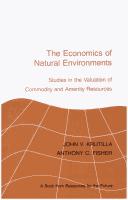| Listing 1 - 10 of 10 |
Sort by
|
Book
ISBN: 1852789743 9781852789749 Year: 1995 Publisher: Aldershot Elgar
Abstract | Keywords | Export | Availability | Bookmark
 Loading...
Loading...Choose an application
- Reference Manager
- EndNote
- RefWorks (Direct export to RefWorks)

ISBN: 0521285941 0521243068 0511572085 0511867433 9780521285940 9780521243063 Year: 1981 Publisher: Cambridge : Cambridge University Press,
Abstract | Keywords | Export | Availability | Bookmark
 Loading...
Loading...Choose an application
- Reference Manager
- EndNote
- RefWorks (Direct export to RefWorks)
This book presents the major themes of the economic literature on natural resources and the environment. It is designed to bring the reader, in part with the aid of a unified model of optimal resource use, to the frontiers of the discipline, using only elementary mathematical models. Features special to exhaustible and renewable resources, including the problems posed by market imperfections, are treated as extensions of the basic model. The theoretical discussion is enriched with examples and applications, including a systematic investigation of the behaviour of resource reserves, costs, prices, and substitution possibilities. Substantial attention to environmental, as well as extractive, resources is a distinctive aspect of this book. The author describes methods of estimating the environmental costs of resource development and other projects, and presents some key empirical findings. Policy instruments to protect the environment, such as taxes, subsidies, marketable permits, and direct controls, are carefully analysed from a welfare-theoretic point of view.
Resources, Natural --- Resource-based communities --- Environmental protection. Environmental technology --- Natural resources --- Environmental policy --- Pollution --- Economic aspects --- Environment and state --- Environmental control --- Environmental management --- Environmental protection --- Environmental quality --- State and environment --- Environmental auditing --- National resources --- Resource curse --- Government policy --- Business, Economy and Management --- Economics --- Natural resources. --- Environmental policy. --- Economic aspects. --- Pollution - Economic aspects
Book
ISBN: 3030489582 3030489574 Year: 2020 Publisher: Cham : Springer International Publishing : Imprint: Springer,
Abstract | Keywords | Export | Availability | Bookmark
 Loading...
Loading...Choose an application
- Reference Manager
- EndNote
- RefWorks (Direct export to RefWorks)
This book, based on lectures on natural and environmental resource economics, offers a nontechnical exposition of the modern theory of sustainability in the presence of resource scarcity. It applies an alternative take on environmental economics, focusing on the economics of the natural environment, including development, computation, and potential empirical importance of the concept of option value, as opposed to the standard treatment of the economics of pollution control. The approach throughout is primarily conceptual and theoretical, though empirical estimation and results are sometimes noted. Mathematics, ranging from elementary calculus to more formal dynamic optimization, is used, especially in the early chapters on the optimal management of exhaustible and renewable resources, but results are always given an economic interpretation. Diagrams and numerical examples are also used extensively. The first chapter introduces the classical economists as the first resource economists, in their discussion of the implications of a limited natural resource base (agricultural land) for the evolution of the wider economy. A later chapter returns to the same concerns, along with others stimulated by the energy and environmental “crises” of the 1970s and beyond. One section considers alternative measures of resource scarcity and empirical findings on their behavior over time. Another introduces the modern concept of sustainability with an intuitive development of the analytics. A chapter on the dynamics of environmental management motivates the concept of option value, shows how to compute it, then demonstrates its importance in an illustrative empirical example. The closing chapter, on climate change, first projects future changes and potential catastrophic impacts, then discusses the policy relevance of both option value and discounting for the very long run. This book is intended for resource and environmental economists and can be read by interested graduate and advanced undergraduate students in the field as well.
Environmental economics. --- Economics --- Environmental quality --- Environmental aspects --- Economic aspects --- Natural resources. --- Energy policy. --- Energy and state. --- Environmental management. --- Economic theory. --- Environmental Economics. --- Natural Resources. --- Energy Policy, Economics and Management. --- Environmental Management. --- Economic Theory/Quantitative Economics/Mathematical Methods. --- Economic theory --- Political economy --- Social sciences --- Economic man --- Environmental stewardship --- Stewardship, Environmental --- Environmental sciences --- Management --- Energy and state --- Power resources --- State and energy --- Industrial policy --- Energy conservation --- National resources --- Natural resources --- Resources, Natural --- Resource-based communities --- Resource curse --- Government policy
Digital
ISBN: 9783030489588 Year: 2020 Publisher: Cham Springer International Publishing
Abstract | Keywords | Export | Availability | Bookmark
 Loading...
Loading...Choose an application
- Reference Manager
- EndNote
- RefWorks (Direct export to RefWorks)
This book, based on lectures on natural and environmental resource economics, offers a nontechnical exposition of the modern theory of sustainability in the presence of resource scarcity. It applies an alternative take on environmental economics, focusing on the economics of the natural environment, including development, computation, and potential empirical importance of the concept of option value, as opposed to the standard treatment of the economics of pollution control. The approach throughout is primarily conceptual and theoretical, though empirical estimation and results are sometimes noted. Mathematics, ranging from elementary calculus to more formal dynamic optimization, is used, especially in the early chapters on the optimal management of exhaustible and renewable resources, but results are always given an economic interpretation. Diagrams and numerical examples are also used extensively. The first chapter introduces the classical economists as the first resource economists, in their discussion of the implications of a limited natural resource base (agricultural land) for the evolution of the wider economy. A later chapter returns to the same concerns, along with others stimulated by the energy and environmental “crises” of the 1970s and beyond. One section considers alternative measures of resource scarcity and empirical findings on their behavior over time. Another introduces the modern concept of sustainability with an intuitive development of the analytics. A chapter on the dynamics of environmental management motivates the concept of option value, shows how to compute it, then demonstrates its importance in an illustrative empirical example. The closing chapter, on climate change, first projects future changes and potential catastrophic impacts, then discusses the policy relevance of both option value and discounting for the very long run. This book is intended for resource and environmental economists and can be read by interested graduate and advanced undergraduate students in the field as well.
Economic schools --- Economics --- Relation between energy and economics --- Environmental protection. Environmental technology --- energiemanagement (economie) --- economie --- economisch denken --- milieubeleid --- milieuzorg --- natuurlijke energiebronnen
Book
ISBN: 0801816998 9780801816994 Year: 1975 Publisher: Baltimore Johns Hopkins university press
Abstract | Keywords | Export | Availability | Bookmark
 Loading...
Loading...Choose an application
- Reference Manager
- EndNote
- RefWorks (Direct export to RefWorks)
Nature protection --- Economic structure --- Natural resources --- Valuation --- United States --- Public lands --- 614.7 --- 504.03 --- 630*907.2 --- 330.15 --- -Natural resources --- -Public lands --- -Lands, Public --- Land use --- Public domain --- Crown lands --- Natural resources, Communal --- National resources --- Resources, Natural --- Resource-based communities --- Resource curse --- Pollutie van lucht, water, grond--(openbare gezondheidszorg) --- Social and socio-economical aspects of human influences on the environment. Social ecology. Ecological economics --- Recreation --- Grondstoffen. Natural resources --- -Law and legislation --- Economic aspects --- -Pollutie van lucht, water, grond--(openbare gezondheidszorg) --- -614.7 --- 330.15 Grondstoffen. Natural resources --- 630*907.2 Recreation --- 504.03 Social and socio-economical aspects of human influences on the environment. Social ecology. Ecological economics --- -330.15 Grondstoffen. Natural resources --- Lands, Public --- BLM lands --- Bureau of Land Management lands --- Natural resources - United States --- Natural resources - Valuation --- United States - Public lands

ISBN: 0915707195 Year: 1985 Publisher: Baltimore Johns Hopkins university press
Abstract | Keywords | Export | Availability | Bookmark
 Loading...
Loading...Choose an application
- Reference Manager
- EndNote
- RefWorks (Direct export to RefWorks)
Natural resources --- Public lands --- Valuation --- 614.7 --- -Natural resources --- -Public lands --- -Lands, Public --- Land use --- Public domain --- Crown lands --- Natural resources, Communal --- National resources --- Resources, Natural --- Resource-based communities --- Resource curse --- Pollutie van lucht, water, grond--(openbare gezondheidszorg) --- -Law and legislation --- Economic aspects --- -Pollutie van lucht, water, grond--(openbare gezondheidszorg) --- -614.7 --- BLM lands --- Bureau of Land Management lands

ISBN: 1280747285 9786610747283 0080468039 0444528555 9780444528551 9780080468037 Year: 2007 Publisher: Amsterdam ; Boston : Elsevier,
Abstract | Keywords | Export | Availability | Bookmark
 Loading...
Loading...Choose an application
- Reference Manager
- EndNote
- RefWorks (Direct export to RefWorks)
This book is organized into 4 sections, each looking at the question of outcome prediction in cancer from a different angle. The first section describes the clinical problem and some of the predicaments that clinicians face in dealing with cancer. Amongst issues discussed in this section are the TNM staging, accepted methods for survival analysis and competing risks. The second section describes the biological and genetic markers and the rôle of bioinformatics. Understanding of the genetic and environmental basis of cancers will help in identifying high-risk populations and developing effectiv
Cancer --- Neural networks (Computer science) --- Survival analysis (Biometry) --- Diagnosis. --- Prognosis. --- Analysis, Survival (Biometry) --- Survivorship analysis (Biometry) --- Artificial neural networks --- Nets, Neural (Computer science) --- Networks, Neural (Computer science) --- Neural nets (Computer science) --- Biometry --- Failure time data analysis --- Artificial intelligence --- Natural computation --- Soft computing
Book
ISBN: 9783030489588 Year: 2020 Publisher: Cham Springer International Publishing :Imprint: Springer
Abstract | Keywords | Export | Availability | Bookmark
 Loading...
Loading...Choose an application
- Reference Manager
- EndNote
- RefWorks (Direct export to RefWorks)
Economic schools --- Economics --- Relation between energy and economics --- Environmental protection. Environmental technology --- energiemanagement (economie) --- economie --- economisch denken --- milieubeleid --- milieuzorg --- natuurlijke energiebronnen

ISBN: 9780444528551 0444528555 9780080468037 0080468039 Year: 2007 Publisher: Amsterdam Boston Elsevier
Abstract | Keywords | Export | Availability | Bookmark
 Loading...
Loading...Choose an application
- Reference Manager
- EndNote
- RefWorks (Direct export to RefWorks)
This book is organized into 4 sections, each looking at the question of outcome prediction in cancer from a different angle. The first section describes the clinical problem and some of the predicaments that clinicians face in dealing with cancer. Amongst issues discussed in this section are the TNM staging, accepted methods for survival analysis and competing risks. The second section describes the biological and genetic markers and the r̥le of bioinformatics. Understanding of the genetic and environmental basis of cancers will help in identifying high-risk populations and developing effective prevention and early detection strategies. The third section provides technical details of mathematical analysis behind survival prediction backed up by examples from various types of cancers. The fourth section describes a number of machine learning methods which have been applied to decision support in cancer. The final section describes how information is shared within the scientific and medical communities and with the general population using information technology and the World Wide Web. * Applications cover 8 types of cancer including brain, eye, mouth, head and neck, breast, lungs, colon and prostate * Include contributions from authors in 5 different disciplines * Provides a valuable educational tool for medical informatics.
Book

ISBN: 9781501741012 Year: 2019 Publisher: Ithaca, NY
Abstract | Keywords | Export | Availability | Bookmark
 Loading...
Loading...Choose an application
- Reference Manager
- EndNote
- RefWorks (Direct export to RefWorks)
| Listing 1 - 10 of 10 |
Sort by
|

 Search
Search Feedback
Feedback About
About Help
Help News
News